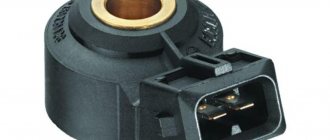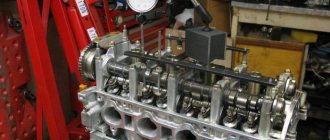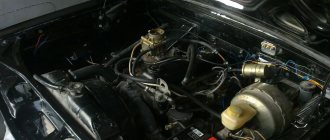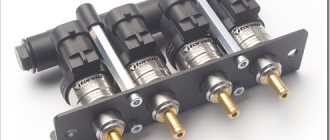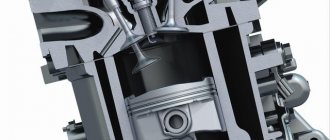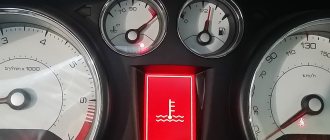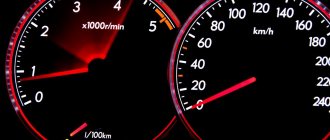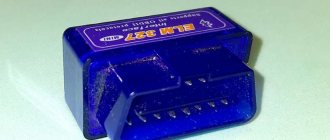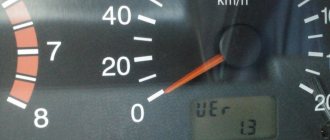Without exception, all VAZ cars, from model 2101 to modern versions, are equipped with gasoline power plants, which are a higher priority for all automobile manufacturers.
The normal functioning of any gasoline engine is ensured by a number of factors - maintaining the correct proportion of the air-fuel mixture, the quality of gasoline, the appropriate ignition timing, and the condition of the CPG. If at least one of these factors does not correspond, a negative effect such as detonation may occur.
Detonation - what is it?
Detonation is simply improper combustion of the mixture. But if measures are not taken in time, then the detonation of a VAZ engine can have strong negative consequences. The peculiarity of this effect lies in the self-ignition of the combustible mixture due to exposure to high temperatures and pressure in the cylinders.
During normal engine operation, combustion of the combustible mixture occurs in three stages.
- Induction, takes place as the piston approaches top dead center. At this stage, a source of flame begins to appear from a spark, which subsequently forms a flame front, and all this is accompanied by a slight increase in pressure in the combustion chamber.
- The formation and passage of a flame front through the combustion chamber, as a result of which the bulk of the mixture burns, and this is all accompanied by a sharp increase in pressure and temperature.
- Burning out of the mixture residues that remained behind the front, as well as those located near the cylinder walls. It is between the transition from the second stage to the third that detonation may occur. The high temperature and pressure that occurs during the second stage leads to rapid chemical reactions in the unburned mixture, causing it to spontaneously ignite. Such combustion occurs very quickly (up to 1200 m/s) and in the form of an explosion, accompanied by the formation of shock waves that are destructive.
Related link:
Tricks of buying a used car using the example of a VAZ
These waves lead to the destruction of the near-wall layers of gases, which ensures an increase in heat transfer, due to which the cylinder walls and other components of the CPG overheat. Also, the blast wave destroys the oil film of the walls, resulting in increased friction between the cylinders and rings. Detonation also has a mechanical effect on the elements of the piston group - a sharp increase in pressure leads to the appearance of shock loads on the piston bottom, valve, and cylinder walls, leading to their damage.
The figure shows how normal and detonation combustion of fuel occurs.
On the left – normal combustion; on the right – detonation combustion
VAZ 2109: engine detonation - how to remove it?
Installing the engine on a VAZ 2109
For the VAZ 2109 car, the main power unit is the engine. The service life of the entire vehicle and traffic safety depend on its reliable operation. The appearance of a loud metallic knock, a noticeable decrease in power, instability in engine operation, emissions of black smoke from the exhaust pipe, a decrease in the temperature of the exhaust gases may indicate that engine detonation has occurred on the VAZ 2109. The article suggests getting acquainted with its consequences and methods of dealing with it yourself.
Causes
If we consider this effect only on the engines of VAZ cars, then it can occur on any of them - both an obsolete engine of model 2106, and a modern installation of the same version 2114, etc.
There are certain reasons for VAZ detonation, and they are as follows:
- Incorrect proportions of the combustible mixture. In an overly enriched combustible mixture, after entering the cylinder, due to exposure to high temperatures in remote corners of the combustion chamber, oxidation processes may occur, which are the root cause of detonation;
- Ignition timing violation. As the angle increases, all processes in the cylinders take place even before it approaches TDC. Hence the high pressure and temperature, and the appearance of chemical reactions with part of the mixture.
- Octane number. The lower it is, the higher the likelihood of detonation. This is all explained by the fact that low-octane gasoline is more susceptible to reactions.
- High compression ratio. An increase in this parameter above the norm leads to increased pressure and temperature in the cylinders, which are catalysts for the occurrence of reactions.
All the described factors for the appearance of this effect are the same for all gasoline engines, therefore the reasons for detonation of a carburetor engine are the same as for an injection engine.
Factors affecting detonation
There may be many reasons for the appearance, but they have one thing in common - the delay in spontaneous combustion of the air-fuel mixture (unburned portion) removed from the electrodes of the spark plug is reduced. To put it simply, all the conditions appear in the combustion chambers for oxidative processes to occur. The occurrence of detonation is affected by:
- Qualitative composition of the combustible mixture. If the air/gasoline ratio = 0.9, then the fuel mixture, when it enters the combustion chambers, forms pockets in various places. It is in them that oxidative reactions begin to occur, and they subsequently ignite.
- The increased ignition timing leads to the fact that the maximum pressure during combustion of the mixture is observed at the moment when the piston is almost at top dead center. As a result, the pressure increases and detonation occurs.
- Too low octane number of gasoline affects the appearance of characteristic knocking sounds. If you refuel with AI-92 gasoline, then when AI-80 enters the tank, the operation of the engine will change, and significantly. To avoid such problems, you need to buy fuel at trusted gas stations. Or option 2 - installing an octane corrector.
- The higher the compression ratio, the higher the octane number the gasoline should have.
The design features of the engine affect the occurrence of detonation, but to a lesser extent.
Detonation and glow ignition
There are cases when detonation occurs when the ignition of a VAZ-2106 or any other version is turned off. That is, the power plant continues to operate independently even after the spark supply is stopped. Here, too, the process of self-ignition occurs, but it occurs for slightly different reasons. Such ignition occurs from some excessively heated elements of the CPG. This effect is called “glow ignition”, and this is no longer detonation of the VAZ-2106 engine. These two concepts should not be confused as they are completely different.
Related link:
Driving a car in icy conditions
Article on the topic - How to deal with glow ignition
Can a car engine detonate when turned off: let’s understand the aspects
It is wrong to classify uneven engine operation or any other knocking as a sign of detonation. To avoid mistakes, the best option would be to find out what the detonation mode sounds like in practice. For example, watch thematic video files.
Dieseling
As already noted, an undesirable phenomenon can appear exclusively on a functioning motor. How then to qualify the operation of the power plant with the ignition off? The mechanics' answer is short - dieseling. Its nature is different: self-ignition of gasoline, identical to the working process of a diesel engine.
Beginners who have caught up on their knowledge base on gasoline internal combustion engines will immediately object, citing a couple of arguments “against”: high-octane fuel has poor self-ignition ability, and the compression ratio in a gasoline engine is lower. All this is true, but when the unit is stopped, favorable conditions are created for dieseling.
- Fuel supply to the cylinders.
- Low crankshaft speed.
Consequences. Fighting methods
Detonation of a carburetor engine is accompanied by the appearance of a metallic knock, especially under load. Many people perceive it as the “ringing of fingers” of the pistons, but the distinct sound, as if metal is hitting metal, is due to the blast wave.
The consequences of this effect, if no measures are taken, are very serious. Overheating of the component parts can lead to breakdown of the block head. The absence of an oil film, which is destroyed due to the effects of detonation, increases friction and leads to accelerated wear of the CPG elements. And finally, the mechanical impact of the shock wave together with high temperature can cause the piston to burn out, destroy the bridges between the rings, bend the connecting rod, and burn out the valve plates.
Consequences of detonation combustion of the mixture
| Piston burnout |
Valve burnout
Features of injection engines There are several ways to effectively combat this effect on carburetor engines. First of all, when detonation occurs, the fuel should be replaced, especially if the fuel was previously refueled at a station with questionable fuel quality. If the fuel does not cause suspicion, then it is worth checking the ignition and setting a later advance angle by turning the distributor.
The causes of detonation in an injection engine are identical to that of a carburetor, but in addition to metallic ringing, such engines have a number of other signs indicating the occurrence of this effect.
And all because the engine with such a power system is more advanced. Its processes of mixture formation and supply of mixture to the cylinders are controlled by an electronic control unit based on the readings of many sensors. Also, depending on the operating mode of the engine, he also independently selects and sets the advance angle. That is, the driver can no longer set the ignition on his own.
The electronic unit is able to track the occurrence of detonation. For this purpose, all injection engines are equipped with a knock sensor (DS).
Related link:
Tire center koleso.ru
Knock sensor
This sensor is capable of detecting the appearance of detonation combustion, and the ECU will take action based on its data. For example, if the cause of detonation of a VAZ-2109 engine equipped with an injection power system is low-quality fuel, and the sensor detects the effect, the ECU will simply reduce the ignition timing and the detonation will stop.
Briefly about the main thing
After stopping the engine, there can be no detonation - this unstable “jerking” is called dieseling. This phenomenon does not carry anything dangerous in itself. The reason for its appearance is the flow of fuel into the cylinders when the ignition is turned off. It occurs, as a rule, on carburetor engines with a faulty EMC.
Detonation occurs exclusively when the engine is running and is accompanied by a characteristic metallic ringing. It appears when driving at low speeds under load, when starting off, after refueling with low-octane gasoline and due to incorrect setting of the ignition timing on a carburetor engine. On an injection power plant, the engine knock sensor and the ECU are responsible for the latter.
Knock sensor, how it works
Structurally, all knock sensors are the same and are based on the piezoelectric effect, that is, the mechanical action is converted into electrical action. And the greater the mechanical impact, the more energy the sensor is able to generate.
The main component of this sensor is a piezoelectric element, which generates electric current from mechanical action. During normal operation, this sensor generates low-power electrical pulses that are not transmitted by the resistor included in the design.
During detonation, shock loads and vibration increase significantly, therefore the impact on the piezoelectric element increases. When a certain current generated by the sensor is reached, a breakdown of the resistor occurs and a pulse is sent to the ECU, which is a signal to it that measures must be taken to eliminate the abnormal combustion that has occurred.
Since the DDs operate on the same principle, the design of the VAZ-2110 knock sensor is the same as on models 2107, 2109 (injection versions), 2114, etc.
DD connection diagram
Signs of a malfunctioning knock sensor (DS)
Note that a malfunction of the motor drive can affect the performance of the power plant. The fact is that if the ECU detects that it is not working, it will switch the engine operation to emergency mode, in which the ignition will be delayed in order to completely eliminate the possibility of detonation combustion.
Signs of a malfunction of the VAZ-2110 knock sensor are as follows:
- Unstable engine operation at idle;
- Decrease in engine power performance;
- Increased gasoline consumption;
- Difficulty starting the engine;
In general, everything that is a consequence of late ignition. Signs of a malfunction of the VAZ-2114 knock sensor or any other VAZ injection model are identical.
Related link:
Installation and adjustment of ignition VAZ 2101
But such signs can be given not only by the DD, but also by other sensors responsible for the operation of the power system, so it is important to know how to check the knock sensor of the VAZ-2110. Otherwise, you can spend a long time looking for the cause of the motor’s malfunction. Often car owners do not pay attention specifically to the DD, sinning on other elements.
Where to look and how to check the knock sensor
In order to check it, you also need to know where the VAZ-2110 knock sensor is located. Everything is simple here; so that it can effectively capture vibrations, it is placed on the cylinder block. Its location largely depends on the design features of the motor itself.
On 8-valve engines it is usually located in the line of sight and is usually easy to get to. Therefore, it is not difficult to determine where the knock sensor is located on a VAZ-2107 (injector). It is installed on the exhaust manifold side and consists of a massive washer with wiring going to it and secured to the engine with a bolt.
But on 16-valve engines, the installation location is slightly different than the location of the knock sensor on the VAZ-2107 (injector). Due to the fact that the block head is much more massive, the sensor is located lower - under the exhaust manifold, so access to it is limited, and often it can only be reached from under the car on an overpass or inspection hole.
And although the location of the motor may differ slightly due to the design of the motor, its connection is always identical. Thus, the connection diagram for the VAZ-2109 knock sensor with an injection engine is the same as on the 2114 model.
Checking the VAZ-2110 knock sensor can be done in two ways.
The first of them implies the presence of a tester switched to measuring resistance (measurement level - up to 2 kOhm).
Checking the knock sensor with a tester
To check, you just need to disconnect the wiring block from the sensor and connect a tester to the sensor contacts. Then you should apply light blows with a wrench to the DD fastening bolt and monitor the readings on the tester display.
Related link:
How to sell a car quickly
After connection, the display will show a certain resistance value of the sensor. At the moment of impact on the bolt, the resistance will increase sharply, but then return to the old value. If this does not happen (the resistance does not rise or does not return), the sensor is faulty and requires replacement.
The second method does not require any equipment and is more effective. To carry it out, you need to start the engine and set the speed to 2000 rpm. Then take an open-end wrench, you can use a small hammer with a metal attachment (if access to the DD is limited) and strike the fastening bolt. If the DD is in good working order, after the impact, the engine speed should drop, since such an impact will be regarded by the sensor as detonation and the ECU, based on its signals, will reduce the ignition angle. After the impact on the bolt stops, the speed should be restored. If this does not happen, the DD is faulty.
Replacing the sensor
We figured out how to check the knock sensor of a VAZ-2114 or any other model. Please note that this sensor cannot be repaired and if it is faulty, it must be replaced.
Replacing the VAZ-2114 knock sensor is a simple operation, but it can be difficult due to poor access to it (16-valve engines). To change, you just need a new element and an open-end wrench of the appropriate size.
Before unscrewing the mounting bolt, you must first disconnect the block with wires. Then the bolt is unscrewed, the old sensor is removed, and a new one is installed in its place and securely fixed with the same fastener. And only after that the block with wires is connected.
